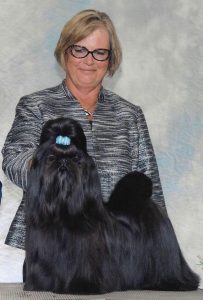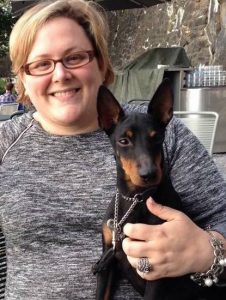570 — Breeding Theory Q&A From LIVE@5
Breeding Theory Q&A From LIVE@5
 Host Laura Reeves leads a conversation on breeding theory, replayed from a LIVE@5 live podcast from 2022.
Host Laura Reeves leads a conversation on breeding theory, replayed from a LIVE@5 live podcast from 2022.
“As we all know, dog breeding is something of, to put it mildly, a passion project,” Reeves said. “Doing it well is something we all strive for. There are some tools that we can use to accomplish that goal. No matter what type of breeding program we have, we can all use these same tools to achieve success. Sort of the theory side of breeding, reading pedigrees, breeding concepts and health testing.
“Coefficient of inbreeding is frequently shortened to COI. One of the great things is if you test both the sire and the dam of your litter, you will be able to get a predicted genetic COI based on the actual DNA. Then if you DNA test each of the puppies in your litter, you will be able to get an exact genetic DNA coefficient of inbreeding that will tell you exactly (what each puppy is). I think one of the things that many of us find sort of mind blowning is that puppies in a litter do not all have the same COI. They don’t all have the same genetics.
“And so when I did a half brother, half sister, a straight up inbreeding that I’d been planning for quite some time, and I knew what the pedigree COI was, I knew what the estimated or expected genetics COI was going to be, and I Embarked each of the 13 puppies and the actual COI in each of those puppies varied by as much as ten basis points.
“So, it’s really, really important to look at some of the tools that are now available to us. Dog breeding has always been a little bit of art and a little bit of science. Science is coming to the forefront and I don’t want us to lose the art, but I want us to be able to make good use of the science.
“Pedigree, genetic and actual COI is a very, very useful tool in our breeding program as we’re going forward. Purebred is a level of inbreeding. That’s what makes it purebred. Having a higher or lower level and how you use that and the healthy genes that you’re doubling up on or the unhealthy genes that you’re doubling up on make any enormous difference in your breeding program going forward.”
Listen in as Laura and her listeners interact on important topics from breeding theories, health testing and more.
Remember that LIVE@5 live podcasts drop on the Pure Dog Talk Facebook page the first Tuesday of every month! Join us there on March 7 for a conversation on GROOMING!
You can get more on this topic at the Dog Breeding 101 seminar.
397 — Planning Your “Family” of Dogs: Style and Health
Planning Your “Family” of Dogs: Style and Health
Our topic is breeding. With an emphasis on planning your family of dogs. The question: is consistency of style more important than consistency of health and/or quality? How do you get to your desired goals?
Today’s guests are Amanda Kelly, Wendy Paquette and Chris Heartz. This is part one of a two part series. Check back next week for part two!
Type to type
 Wendy: “Coming from a background of Shih Tzu, that were only recognized in United States in 1969, I didn’t have much choice when I first started my breeding program. Living in northern Ontario, the only way I could buy a female was to import two from England ’cause they were just not available. Luckily I came across Luc Boileau in Montreal who was showing English imported dogs at the time. So I was able to take my English import and breed it to one of Luc’s dogs. But that left me sort of in a quandary because I had nowhere else to go after that. So I basically started out breeding type to type.
Wendy: “Coming from a background of Shih Tzu, that were only recognized in United States in 1969, I didn’t have much choice when I first started my breeding program. Living in northern Ontario, the only way I could buy a female was to import two from England ’cause they were just not available. Luckily I came across Luc Boileau in Montreal who was showing English imported dogs at the time. So I was able to take my English import and breed it to one of Luc’s dogs. But that left me sort of in a quandary because I had nowhere else to go after that. So I basically started out breeding type to type.
“Consistency of type was a goal, but health and welfare, to me, is a major factor. If you don’t have health and welfare you don’t have quality and type either.
“I have done inbreeding, outcrossing, line-breeding. I’ve done it all throughout the years. It’s easier to do stuff like that if you have quantity of dogs. So there was a point where I had up to 50 Shih Tzu. So I could pick and choose what direction I wanted to take each line.”
Health in a small gene pool
 Amanda: “I think it depends on where your breed is. Every breed is going to be unique. How you approach setting up your own breeding program and also thinking about management of the population as a whole. So there’s a lot of things that come into play in that respect.
Amanda: “I think it depends on where your breed is. Every breed is going to be unique. How you approach setting up your own breeding program and also thinking about management of the population as a whole. So there’s a lot of things that come into play in that respect.
“As breeders, when we talk about getting consistency and cultivating aspects of breed type, we’re often talking about eliminating genetic material. In order to concentrate the genes so that we can get the head that we like or the coat that we like, we’re limiting the genes for the other things.
“(In) very small breeds, we have to not only think about what we want in our own breeding program, but also what is the best choices to make in order to cultivate the things that we think our breed needs now or may need in the future.
Cookie cutters
 Chris: “I sometimes get upset when I put a dog on the table and somebody who I maybe don’t know looks at me and says ‘Another cookie cutter.’ And it drives me crazy because I think of how many disappointments, how many hurdles we had to cross (to get our) cookie cutter right.
Chris: “I sometimes get upset when I put a dog on the table and somebody who I maybe don’t know looks at me and says ‘Another cookie cutter.’ And it drives me crazy because I think of how many disappointments, how many hurdles we had to cross (to get our) cookie cutter right.
“I was lucky enough that instead of a diamond, my husband gave me a dog as an engagement present. That dog was everything we wanted. He wasn’t perfect, but he was where we felt the breed needed to go. He had beautiful shoulders. He had reach and drive. He had a body shape that was not so common because he was actually short backed. We knew the blueprint but we made some mistakes and made some assumptions along the way.
“I have it in big bold letters: if you own a stud dog, he is not always the best breeding for your bitch. It took a long time to figure that out. I see people do it all the time. You have to know what clicks, what doesn’t click and what never to breed together.”


